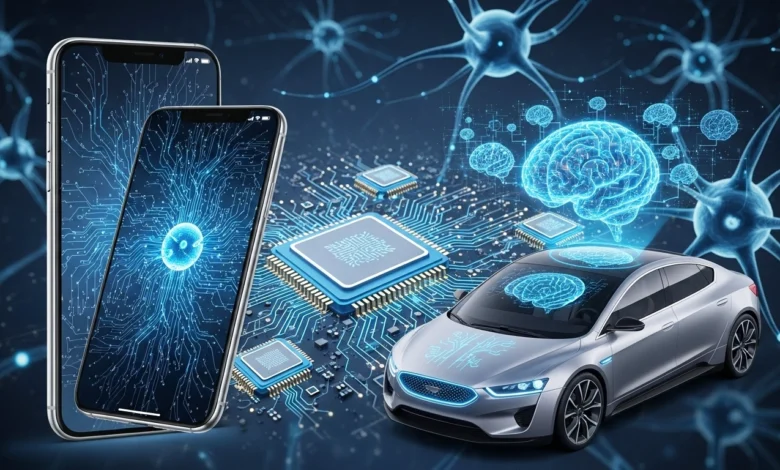Neuromorphic Computing: Brain Inspired Tech for Smarter Phones and Cars

In today’s world, mobile gadgets and self-driving cars demand ever-higher performance without generating excessive heat or draining batteries. Traditional processors struggle to balance raw throughput with energy efficiency, especially when running AI workloads. Neuromorphic computing offers a paradigm shift by emulating the brain’s sparse, event-driven signaling to deliver real-time responsiveness at a fraction of the power. This article unpacks its architecture, benefits, use cases, challenges, and future prospects.
What is Neuromorphic Computing?
Neuromorphic computing is a brain-inspired approach to AI that uses spiking neural networks and event-driven hardware to process information efficiently. Unlike traditional chips, it only consumes power when events occur, enabling real-time AI performance with ultra-low energy usage. This makes it ideal for mobile devices and autonomous vehicles.
-Scientific Background
Classical processors execute instructions in a sequential or parallel pipeline, moving data back and forth between memory and ALUs. In contrast, the human brain processes information via networks of neurons that fire only when input crosses a threshold, greatly reducing wasted cycles. Neuromorphic systems recreate these spiking neural networks in silicon or memristive fabrics, enabling data-driven computation rather than clock-driven execution. This bioinspired model underpins orders-of-magnitude gains in energy efficiency and latency.
-Core Architecture
-
Spiking Neural Networks (SNNs): Nodes communicate through discrete, millisecond-scale voltage spikes rather than continuous activations.
-
Memristors: Emerging components that mimic synaptic plasticity by adjusting resistance based on voltage history.
-
Event-Driven Processing: Computation occurs only when relevant spikes arrive, eliminating idle power draw and data shuttling.
- Hardware Topology: Manycore neuromorphic chips interconnect thousands of neuron-like cores via low-latency meshes.
-Technical Benefits
Neuromorphic chips consume milliwatts instead of watts for equivalent AI inference tasks, extending battery life in phones and wearables. Latencies shrink to microseconds because data never traverses large buses or shared caches. On-device learning becomes feasible, allowing models to adapt continuously to user behavior and environmental changes. Parallel, asynchronous operation also scales naturally across large core counts without complex cache-coherence protocols.
-Neuromorphic Chips vs. Traditional AI Hardware (GPU/TPU)
Comparison: Traditional AI Chips vs. Neuromorphic Chips
| Feature / Metric | GPU / TPU (Traditional AI Chips) | Neuromorphic Chips |
|---|---|---|
| Energy Consumption | Tens to hundreds of watts | Milliwatts to a few watts |
| Processing Model | Clock-driven, synchronous | Event-driven, asynchronous |
| Latency | Milliseconds | Microseconds |
| Learning Capability | Mostly offline (cloud training) | Supports on-chip, real-time learning |
| Scalability | Requires cache coherence, complex interconnects | Naturally parallel, mesh-like interconnect |
| Best Use Cases | Data center training, batch AI | Edge devices, mobile, autonomous vehicles |
Unlike GPUs and TPUs that excel at high-throughput training in data centers, neuromorphic chips are optimized for real-time, low-power inference directly on devices. This makes them complementary rather than direct replacements.
-Use Cases in Mobile Devices
-
Face and Gesture Recognition: Real-time processing of video streams with sub-10 ms response and minimal power impact.
-
Voice Assistants: Local wake-word detection and natural-language preprocessing without routing audio to the cloud.
-
Contextual Personalization: Dynamic adaptation of camera settings, UI themes, or notification filters based on on-device sensor fusion.
- Health Monitoring: Continuous analysis of biometric signals such as ECG or accelerometer data for personalized fitness feedback.Imagine a phone that doesn’t just follow commands but anticipates what you need, all while keeping your data private on the device itself.
-Use Cases in Autonomous Vehicles
-
Vision Processing: Spiking vision sensors paired with neuromorphic cores detect obstacles and signage with microsecond-scale reaction times.
-
Real-Time Decision-Making: Safety systems like emergency braking or lane-keep assist trigger instantly by filtering noise and focusing on salient events.
-
Energy Efficiency: Reduced power draw for AI subsystems extends range in electric vehicles and allows more sensors to operate continuously.
- Sensor Fusion: Asynchronous integration of lidar, radar, and camera inputs into a unified, low-latency perception pipeline.
-Challenges
Neuromorphic hardware relies on novel materials and fabrication techniques, driving up initial production costs compared to mature CMOS processes. Developers must adopt new programming paradigms and tooling to map workloads onto spiking networks rather than traditional tensors. Integration with existing software stacks requires middleware bridges and hybrid processing pipelines. Standard benchmarks and design flows are still in flux, slowing enterprise adoption.
-Key Players and Solutions
-
IBM TrueNorth: A 1 million-neuron chip demonstrating large-scale SNN inference at sub-100 mW power budgets.
-
Intel Loihi: A many-core neuromorphic research processor with on-chip learning capabilities and a versatile SDK.
-
Qualcomm Zeroth (research): Early mobile-targeted neuromorphic engines integrated into Snapdragon platforms.
- BrainChip Akida: A commercial edge AI accelerator leveraging asynchronous spiking for vision and sensor workloads.
-Software Ecosystem
-
Nengo: A Python-based simulator and compiler that targets neuromorphic hardware backends.
-
Brian2: An extensible spiking neural network simulator for rapid prototyping of neuron models.
-
SNNToolbox: Conversion framework from standard deep nets to spiking equivalents optimized for inference.
- Loihi SDK & NxSDK: Intel’s development suite for model design, mapping, and real-time experimentation on Loihi chips.
-Future Outlook and Roadmap
Commercial neuromorphic modules are entering low-power IoT gateways and specialized edge devices today, with broader mobile and automotive integration estimated within the next 3–5 years. Advances in memristor yield and hybrid CMOS-memristor fabrication promise further miniaturization and cost reduction. Research is exploring coupling neuromorphic cores with quantum accelerators to tackle combinatorial optimization tasks. As standards coalesce and the ecosystem matures, neuromorphic computing will redefine how we build responsive, energy-aware intelligent systems.


